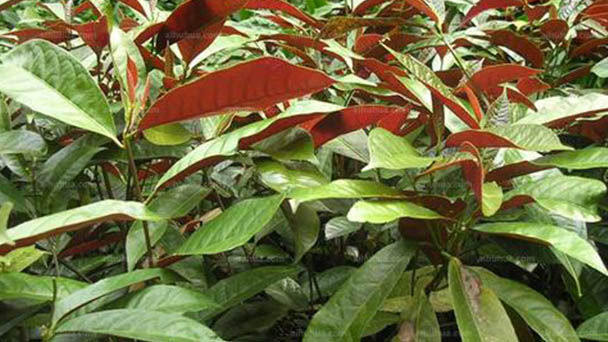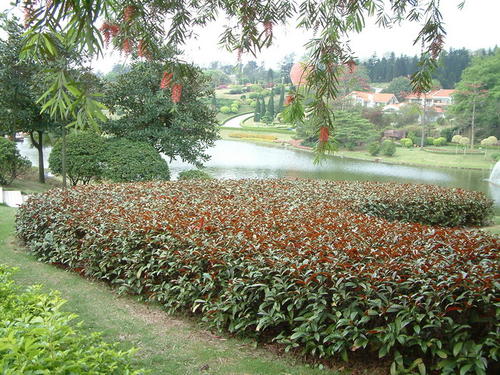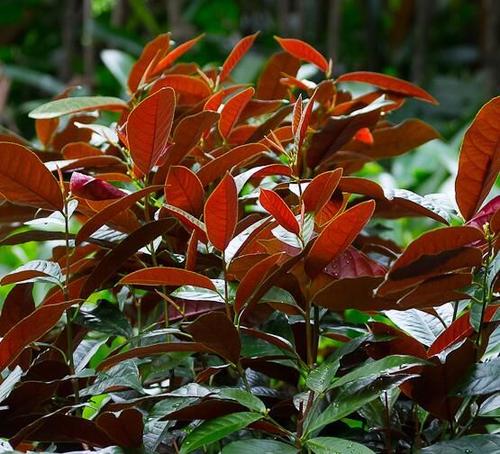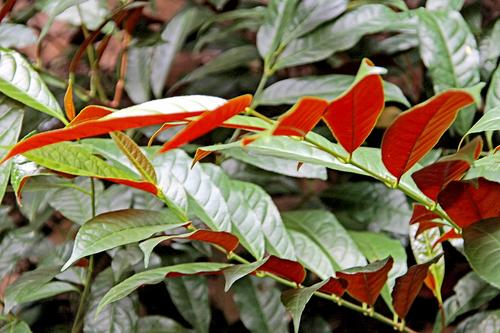Chinese Croton (Excoecaria Cochinchinensis) Profile
Written by Maggie
Dec 07 2021

Chinese Croton (Excoecaria cochinchinensis) is a small evergreen shrub of Euphorbiaceae, which is named for its red leaf back. Chinese Croton is a kind of practical value higher view leaf, view flower plant, in China's Yangtze River valley and the south of the area, commonly used for potted, placed in the windowsill, balcony or garden, but also medicine.
Chinese Croton Picture

Chinese Croton Info
| Botanical Name | Excoecaria cochinchinensis |
| Common Names | Chinese Croton |
| Plant Type | Shrub |
| Sun | Partial sun, shade |
| Hardiness Zones | Zone 9b -3.9 °C (25 °F) to -1.1 °C (30 °F) |
| Flower color | Green, Other: Greenish-yellow |
| Native Area | China |
| Mature size | 3 to 6 feet tall, 2 to 3 feet wide |
Characteristics of Chinese Croton
Chinese Croton Branch
Chinese Croton is an evergreen shrub, up to 1 m tall; Branches are glabrous, with many lenticels.
Chinese Croton Leaf
Chinese Croton leaves are opposite, rare alternate or nearly 3 whorled, papery, narrowly elliptic or oblong, 6-14 cm long and 1.2-4 cm wide, apically long acuminate, basally tapered, margin with sparsely serrated teeth, tooth spacing 3-10 mm, glabrous on both sides, ventrally green, abaxially purplish-red or blood-red; The midvein is raised on both sides, the lateral vein is 8-12 pairs, curved and ascending, the distal edge is curved and arched, the reticulated vein is not obvious; Petiole is 3 -- 10 mm long, glandular free; Stipules are ovate, apically acute, ca. 1 mm long.
Chinese Croton Flowers
The flowers of chinese croton are unisexual, dioecious, and aggregated into axillary or sparse terminal racemes. The male inflorescences are 1 -- 2 cm long, and the female inflorescences consist of 3 -- 5 flowers, slightly shorter than the male. Male flowers: pedicels ca. 1.5 mm; Bracts are broadly ovate, nearly equal in length and width, ca. 1.7 mm, apically convex and serrate, base on the ventral side with 1 gland, each bract with only 1 flower; Chinese Croton has 2 bracteoles, linear, ca. 1.5 mm long, apex acute, distally lacerate with Serrata, base with 1 gland on each side; Chinese Croton has 3 sepals, lanceolate, ca. 1.2 mm long, apically serrate; The stamens extend beyond the sepals, anthers rounded, slightly shorter than filaments. Female flowers: pedicels stout, 1.5 -- 2 mm long, bracts and bracteoles identical to those of male flowers; Chinese Croton has 3 sepals, slightly connate at base, ovate, 1.8 mm long, nearly 1.2 mm wide; Ovary is globose, glabrous, styles 3, detached or more connate at base, ca. 2.2 mm.
Chinese Croton Fruit
The capsule of Chinese Croton globose, ca. 8 mm in diam., truncated at the base, concave at apex; Seeds are subglobose, ca. 2. 5 mm in diameter.
The flowering season of Chinese Croton is almost all year round.
Ecological Habits of Chinese Croton
Chinese Croton is not drought tolerant and not very cold tolerant. The suitable temperature for growth is 15-25℃, and the temperature in winter is not lower than 5℃. Half shade resistance, avoid sun exposure, in summer in the shade, can keep the dark green leaf color. Fertile, well-drained sandy loam soil is required.
How to Care for Chinese Croton
Soil for Chinese Croton
We can use all sorts of quality of basin, and to grow in permeability good grow best in clay soil, but in the indoor owes beautiful, can coat a porcelain bowl, or directly with Yixing pots, plastic pots or porcelain pot, in pelvic floor mat a 5 cm to 8 cm thick layer of rubble or hard plastic foam, enhance its air filter water, in case the roots rotted. The culture soil should be loose and fertile slightly acidic sandy loam, which can be mixed with leaf rot soil and garden soil in equal amount, and then added with 10%-20% river sand or perlite. Turn over the basin for soil 2 years, and as the plant grows up and change to use a large basin, avoid with a large basin planted seedlings, otherwise not only the growth is not good, there is a risk of the rotting root.
Chinese Croton Watering & Fertilizer
Back laurel like wet, but avoid waterlogging. In the growing season to often water, keep the basin soil moist, but avoid waterlogging, to increase the humidity of the air and reduce the temperature. For indoor cultivation, a larger plate can be placed under the basin. Water is often poured into the plate to allow it to evaporate naturally to achieve the effect of increasing and cooling in a small range. Winter 7 days -10 days of water, with partial dry a few better, too wet rot root, too dry plant water loss, yellow leaves fall off, even death. Planting or changing the pot for soil can be applied to the compound fertilizer as base fertilizer, growing period about half a month application of compound fertilizer containing nitrogen, phosphorus and potassium, flowering can be added two spray 0.2% potassium dihydrogen phosphate solution.No fertilization in summer and winter.
Chinese Croton Growing Conditions
Chinese Croton is a subtropical plant that likes warmth and is slightly cold tolerant. It likes half overcast, like scattering light, and avoid strong light is shot straight, the reason is placed in indoor appropriate air is current, and near the windowsill of the brighter sitting room, study, park parallel with the line of sight or the place with a bit taller, can see the two sides of the leaf at the same time, watch and admire the effect is better. Outdoor Chinese Croton should be placed under the tree or the north wall, such as direct light, easy to burn dry leaves, water loss ornamental value. At the same time we should pay attention to no matter any season, whether indoor or outdoor, such as overshade is poor growth. Winter should be moved into the room, placed in front of the window can accept direct light, keep the room temperature above 0℃, can be safe over the winter.
Pruning Chinese Croton
Chinese Croton is naturally branch, but to make the tree beautiful, need an appropriate clip, spring clip, will cut the old branch cuttings, in late June and July but a little from shearing old branches germination and the spring cuttings have half lignification of twigs and 10 cm to 15 cm long, will be in the blade cut, dip in b12 or sulfur powder, abt, insert without fertilizer, sand, water, placed in the shade, often to the foliar spray moisturizing, about 1 month can take root, transplanting engraftment in January to the zone. In addition to plant more than four or five years of the large cluster of Chinese Croton, can be turned over the basin in the spring for soil, the use of plant multiplication method, the plant from the root connection with a knife cut into a number of potted plants can be, but avoid divided too small, each pot should have at least 3 strains -5 strains of the erect stem.

How to Propagate Chinese Croton
Due to the large demand for Chinese Croton seedlings, the rapid cutting seedling raising method is widely adopted.
Disease Control of Chinese Croton
Chinese Croton common anthrax, leaf blight and root-knot nematode disease harm.
Anthracnose and leaf blight were sprayed with 65% zinc-WP 500 times solution, and root-knot nematode disease was controlled with 3% carbofuran granules.
Distribution of Chinese Croton
Chinese Croton is distributed in Guangdong, Guangxi, Yunnan and other southern regions of China.
Chinese Croton Uses
Medical Use
Chinese Croton has the function of activating collaterals and relieving pain. For measles, mumps, tonsillitis, angina pectoris, renal colic; Lumbar muscle strain.
Landscape Use
Chinese Croton leaves float sayin, pure and fresh and beautiful, potted plants often "ornament" indoor hall, bedroom (not suitable for long-term put indoor, carcinogenic possibility, derived from the "science and technology of light), used in gardens, parks, residential area greening south, dense cluster, bright color, and constitutes natural, traditional landscape buildings or trees.
Toxicity of Chinese Croton
Chinese Croton will secrete cancer-promoting substances, which are not only toxic throughout the whole body, but even the soil planted with such plants has been detected to contain the active components of carcinogens. Chinese Croton is a carcinogenic plant, which can induce nasopharyngeal carcinoma and esophagus. Chinese Croton milk is highly toxic and contains substances that activate the Epstein-Barr virus.

Latest Updated
- Benefits of Bugleweed - 7 Science-backed Health Benefits
- Bugleweed Dangers & Side Effects - Is It Poisonous?
- How to Plant Evergreen Trees - What You Should Know
- When to Plant Evergreens - Grow Guide for Evergreen Trees
- 12 Wonderful Evergreen Shrubs for Your Garden
- 12 Popular Evergreen Plants with Pictures for Beginners
- When And How To Prune A Lilac Bush Like a Pro
- How to Grow & Care for Lilac Vine (Hardenbergia Violacea)
- Japanese Lilac Tree (Syringa Reticulata) Care & Propagation Guide
- Shumard Oak Pros and Cons - What to Know
Popular Articles
- Winter maintenance of Antirrhinum Majus
- How to Grow Terminalia Mantaly Tree
- How to Grow and Care for Crossostephium Chinense
- How to grow Antirrhinum Majus in spring
- Peristeria Elata (Dove Orchid) Profile: Info & Care Guide
- Underwatered Snake Plant (Sansevieria Trifasciata) - Signs And How To Fix
- How to Care for Brazilian Jasmine Plant (Mandevilla Sanderi)
- How to Grow & Care for Graptopetalum Purple Delight in Summer
- Rosa Chinensis (China Rose): Plant Growing & Care Tips
- How to Care for Baby Sun Rose (Aptenia Cordifolia)